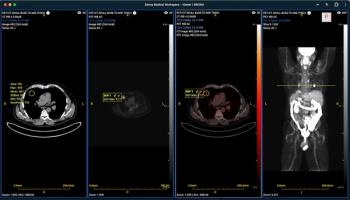
Toshiba pins hopes for growth in ultrasound on Aplio
U.S. market remains tough sellToshiba's high-end Aplio may be the key to the vendor's future in diagnostic ultrasound, according to company executives, who are hatching an elaborate marketing plan to launch the system in the coming
U.S. market remains tough sell
Toshiba's high-end Aplio may be the key to the vendor's future in diagnostic ultrasound, according to company executives, who are hatching an elaborate marketing plan to launch the system in the coming weeks. Thus far, customers have ordered only two systems and none has been shipped, even though the product cleared the FDA Nov. 13 (SCAN 1/9/02). This reflects a conscious decision on the part of Toshiba managers to go slowly-to orchestrate a marketing program that would ensure maximum visibility and optimize sales, executives said.
"We're going to go beyond what we've done previously (with other product launches), because we really want to do this one right," said Lani Young, marketing manager for ultrasound. "We're not planning to ship our first system until April."
Toshiba is banking heavily on the success of this system, which will have a sticker price between $175,000 and $200,000. Company strategists hope Aplio will pull Toshiba within reach of the three powerhouses of the U.S. ultrasound marketplace: Philips, Siemens, and GE. In keeping with this goal, Toshiba will focus marketing efforts for Aplio largely on the U.S., believing success here will spill over into international markets.
"The impetus for developing Aplio was to satisfy the U.S. consumer, because the global market has determined there's enormous value in being successful in the U.S.," Young said. "We've taken our time over the last three years to do our homework and see what would appeal to U.S. customers."
Toshiba's marketing strategy is multipronged:
- widespread dissemination of written materials, including sales collateral and brochures emphasizing the product's development for the U.S.;
- road shows highlighting both the Aplio's advantages and clinical findings from beta sites;
- development and implementation of sales and application training programs designed to properly represent the product; and
- development of product packages that appeal to various market subsegments.
Toshiba executives predict the effort will enable the company to sell up to 150 systems in the first year, generating about $30 million.
Heavy emphasis will be placed on promoting certain features, including fast fusion 3D, advanced dynamic flow, and pulse subtraction image optimization. Aplio's multifrequency transducers support fundamental and harmonic frequencies as well as multi-Doppler frequencies, resulting in improved border detection and axial resolution and far-field image integrity, according to Toshiba. The marketing program will also emphasize Aplio's ergonomic design, which was developed specifically to reduce musculoskeletal stress to sonographers and maximize patient throughput.
Aplio will be positioned to go head-to-head against other high-end products in the market, including GE's Logiq 9, the Siemens/Acuson Sequoia, and the Philips/ATL HDL5000. It's a formidable group, but Toshiba believes its new product is up to the task.
To outsell the competition, Toshiba must increase its visibility in the clinical community, Young said. The company must develop either a single clinical application or group of applications for which the system produces superior diagnostic results. Toshiba is pinning its hopes on Aplio's fast fusion 3D capability, though other features are also being evaluated for that role. Ultimately, Toshiba hopes success with Aplio will pave the way for the introduction of more specialized systems and increased market share.
"Our biggest challenge is name recognition," Young said. "The other challenge is the incumbent installed base. Customers have quite a bit of loyalty to a particular manufacturer. But with all the merging that's been going on, we're finding that people are becoming uncomfortable with the future of incumbent manufacturers."
It is uncertain, however, that Toshiba can pose a real threat to the top three ultrasound makers. In a recent presentation, Tim Mick, executive vice president of Philips Medical Systems, ranked Toshiba fourth in sales in the estimated $3.1 billion worldwide ultrasound market, a ranking Toshiba did not dispute.
"They're in the top 10 domestically, but they're very far down," said Harvey G. Klein, a prominent ultrasound consultant based in New York City. "The Aplio could do fairly well in the marketplace. I hope they turn things around-they were certainly an important factor in the business in the early 1990s."
But Klein, who said Aplio would be important to Toshiba's future, doubted whether this product would be enough to boost the company into the upper strata of the industry.
"They will never be able to climb into the top three," Klein said, but then demurred. "I shouldn't use the word 'never'."
Toshiba's fall reflects a number of factors, including inconsistent distribution, key sales management turnover, and a lag in innovation, according to a source who asked not to be identified. A second source cited Toshiba's inability to understand the U.S. market and its inferior product upgrade path as reasons for the company's decline.
"They still believe that if they make a good product, it will sell itself," the source said. "They will not persevere with a marketing program long enough to create a perception in the customers' minds."
Young, however, remains hopeful.
"We'd prefer to be number two, but number three would be a good start," she said.
Newsletter
Stay at the forefront of radiology with the Diagnostic Imaging newsletter, delivering the latest news, clinical insights, and imaging advancements for today’s radiologists.
































